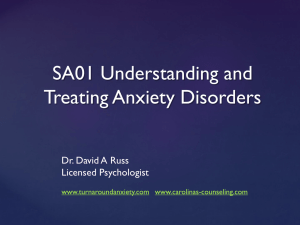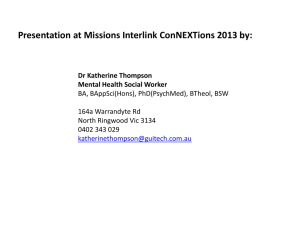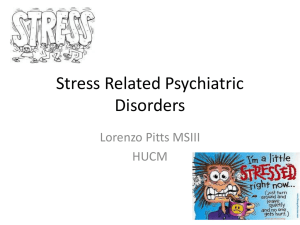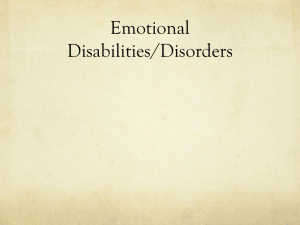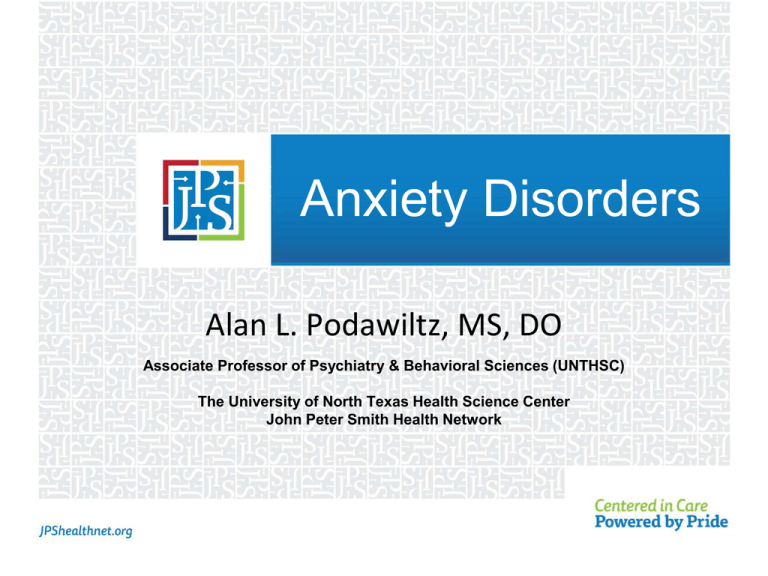
Anxiety Disorders
Alan L. Podawiltz, MS, DO
Associate Professor of Psychiatry & Behavioral Sciences (UNTHSC)
The University of North Texas Health Science Center
John Peter Smith Health Network
What is anxiety?
•
•
•
•
•
•
Universal emotion
State of heightened apprehension
Associated symptoms
Excessive worry
Avoidant of anxiety provoking stimuli
Anxiety results from unknown internal stimuli; excessive
when compared to the existing external stimulus
• Fear is a sense of dread and foreboding in response to
external threat.
(technically not an anxiety disorder)
Biopsychosocial
Affect
Environment
Cognition
Behavior
Anxiety Disorders
1.
2.
3.
4.
5.
6.
7.
8.
9.
Adjustment Disorder With anxiety
Social Phobia (SAD)
Acute Stress Disorder (ASD)
Agoraphobia
Generalized Anxiety Disorder (GAD)
Panic Disorder (PD)
Specific Phobia (SP)
Post Traumatic Stress Disorder (PTSD)
Obsessive-Compulsive Disorder (OCD)
Anxiety Disorders
Core symptoms in Anxiety Disorders is the excessive
experience of anxiety
•
•
•
•
•
•
GAD - no specific triggers > uncontrollable worry
PD – episodic bouts of anxiety
SAD – social, performance
SP – situation or objects
OCD – intrusive ideas > ritualistic behaviors
PTSD – pattern of cognition invoking the emotional
memory of the trauma
Manifestations of Anxiety
• Physical symptoms: autonomic arousal such as
tachycardia, tachypnea, diarrhea, diaphoresis,
lightheadedness
• Affective symptoms: feelings of being edgy, terror “going
to die or lose control”
• Cognitive symptoms: worry, apprehension, obsessions,
thought about body and emotional damage
• Behavior symptoms: avoidance, withdrawal,
compulsions and rituals
Anxiety Disorders (Etiology)
A. Neurophysiology
1. Central noradrenergic systems- locus coeruleus major
source of adrenergic innervation, stimulation – panic
symptoms, blockade- relief of symptoms
2. GABA – limbic system mediate general anxiety, worry
and vigilance.
3. Serotoninergic & neuropeptides – modulates GABA
and noradrenergic systems
Anxiety Disorders (Etiology)
B. Cognitive Behavioral Formulation
1. Role of thoughts and beliefs in activating anxiety
2. Avoidance and escape responses maintain fear and
dysfunctional thinking patterns.
C. Psychodynamic Formulation
Signal of threat to the ego, current events have
similarities to threatening developmental events.
Anxiety Disorders -Public Health Aspects
Common group of disorders
• One in four reports a lifetime history of one (or more)
anxiety disorders
• 30 million have suffered anxiety disorders 6% men, 13%
women within the last 6 months
• Often seen in primary care settings
• Chronic and complicated with depression and
substance abuse
Prevalence of Anxiety Disorders in US
Population
Lifetime
Prevalence (%)
12 months
(%)
Any Anxiety
Disorder
24.9
17.2
Panic Disorder
3.5
2.3
Agoraphobia
5.3
2.8
Social Phobia
13.3
7.9
Simple Phobia
11.3
8.8
Generalized
Anxiety Disorder
5.1
3.1
Disorder
Post Traumatic Disorder
(Diagnosis)
A. Exposure to a traumatic event in which both of the
following were present:
• Experienced, witnessed or confronted with an event
that involved threat to life, physical integrity to self or
others or serious injury.
• Response was intense fear, helplessness and horror.
Post Traumatic Disorder
(Diagnosis)
B. The traumatic event is persistently experienced in one or
more of the following ways: (Re-experiencing)
• Recurrent and intrusive recollections of the event
• Acting or feeling as if the event were recurring
• Intense psychological distress at exposure to internal
or external cues symbolizing or resembling the event.
• Physiological reactivity on exposure to the internal or
external cues symbolizing or resembling the event.
Post Traumatic Disorder
(Diagnosis)
C. Persistent avoidance of stimuli associated with the
trauma and numbing of general responsiveness as
indicated by 3 or more of the following: (Numbing)
• Efforts to avoid thoughts, feelings or conversation
(associated with the trauma)
• Efforts to avoid activities, places or people arousing
recollections of the trauma
• Inability to recall important aspect of the trauma
• Markedly diminished interest or participation in
significant activities.
• Feeling of detachment or estrangement from others
• Restricted range of affect
• Sense of a foreshortened future
Post Traumatic Disorder
(Diagnosis)
D. Persistent symptoms of increased arousal as indicated
by two (or more) of the following: (i.e. hyperarousal)
• Difficulty falling or staying asleep
• Irritability or outbursts of anger
• Difficulty concentrating
• Hypervigilance
• Exaggerated startle response
Post Traumatic Disorder
(Diagnosis)
•
•
Duration of symptoms B,C,D is more than one month
The disturbance causes clinically significant distress
and functional impairment.
• Acute: duration less than 3 months
• Chronic: duration 3 months or more
• With delayed onset: onset of symptoms at least 6
weeks after the stressors
Post Traumatic Stress Disorder (Etiology)
Trauma/Stressor (PTSD, Acute Stress Disorder, Adjustment
Disorder)
The subjective experience of the stress is more significant
factor than objective severity in development of the
disorder
Post Traumatic Stress Disorder (Etiology)
• Childhood trauma, personality disorders, poor support
system, recent life stressors, excessive alcohol use and
perceived external locus of control as opposed to
internal are all predisposing factors that increase
vulnerability.
• Neurotransmitter imbalance, increase ANS response
• Partial ability to cognitively cope with the event
Post Traumatic Stress Disorder (Etiology)
Behavioral model:
Phase 1: unconditioned stimulus (trauma) is paired with
the conditioned stimulus (physical, mental reminders of the
trauma).
Phase 2: Instrumental learning: pattern of avoidance of
both stimulus
Psychoanalytic model: reactivation of previously quiescent,
unresolved psychological conflict.
Post Traumatic Stress Disorder
(Epidemiology)
Prevalence:
• Lifetime general population 1-3 %
• High risk group: 5-75 %
• Vietnam veterans: 30%
Age of onset:
• Any age, usually young adult
Common types of trauma:
• Men - combat
• Women - rape
• Both - accidents, assault, natural disasters
Panic Disorder - (Diagnosis)
Recurrent, spontaneous, primary panic attacks (4 out
13 panic symptoms)
At least one of the attacks has been followed by 1 mo.
or more of one or more:
• Persistent concern about having an attacks
• Worries about implications of the attack
• Behavioral changes related to the attacks (avoidance phobic
symptoms)
Eponyms of Post Traumatic Stress Disorder
In Various U.S. Wars
War
____
Civil War
WW I
WW II
Vietnam War
Gulf War
Disorder
_______
Irritable Heart
Effort Syndrome
Combat Stress Reaction
Post Traumatic Stress Disorder
Gulf War Syndrome ?
(fatigue, shortness of breath, palpitations,
headache, muscle and joint pain, dizziness,
disturbed sleep, difficulty concentrating and
forgetfulness)
Most Upsetting Trauma in Primary Care
Cases of PTSD
Sexual Assault : 23%
Accident: 19%
Witness Death Injury: 15%
Nonsexual violence:15%
Natural disaster: 9%
Post Traumatic Stress
Disorder (Treatment)
Pharmacotherapy: at least one year.
Effective in depression, anxiety and hyperarousal:
TCAs, MAOIs; AEDs, clonidine, beta blockers
Post Traumatic Stress Disorder (Treatment)
• Psychotherapy: time limited to prevent
dependency and chronicity
• Acute: crises intervention, support, education, development of
coping skills
• Chronic: exposure - imaginal or in vivo (lasting effect) stress mgt
– relaxation and CBT (rapid effect)
• Group therapy: shared experience
Obsessive Compulsive Disorder
(Diagnosis)
Distress either obsessions or compulsions:
Obsessions:
1.
2.
3.
4.
Recurrent, persistent, intrusive or inappropriate
thoughts, images or impulses
Not simply excessive worries about real-life problems
Attempts to ignore or suppress thoughts, impulses or
images
Individual recognizes that the thoughts, impulses, or
images are a product of his or her mind
Obsessive Compulsive Disorder
(Diagnosis)
Compulsions:
1.
2.
Repetitive behaviors that a person feels driven to
preform
Behaviors or mental acts are aimed at preventing
dreaded event or reducing anxiety
Obsessive Compulsive Disorder
(Diagnosis)
• Recognition that the obsessions and
compulsions are excessive or unreasonable
• The obsessions or compulsions cause marked
distress and are time consuming (more than 1
hr/day)
• Functional impairment secondary to the
condition
Obsessive Compulsive Disorder
(Course and Prognosis)
• Onset may be sudden or following a stressful
life events
• Often kept secret for years
• 1/3 have significant improvement, 1/3 moderate
improvement, & 1/3 have no improvement
• Good prognosis for sudden onset and good
ability to resist compulsions (with insight)
Obsessive Compulsive Disorder
(Treatment)
• Pharmacotherapy: SSRIs are of choice, clomipramine (a
serotonergic TCA), atypical antipsychotics
• Behavior therapy: exposure & response prevention
(ERP), assertiveness training
• Surgery: cingulotomy, subcaudate tractotomy,
stereotactic limbic leukotomy
• Treat usual comorbid disorders: Tourette’s disorder,
depression, psychosis, eating disorders and body
dysmorphic disorder.
Obsessive Compulsive Disorder
(Clinical Pearls)
•
•
•
•
Recognition is usually difficult, collateral information
needed
Partial treatment response common
Longer trial period and higher doses of SSRIs,
clomipramine
Combination therapy considered optimal for long term
treatment (i.e. CBT* and antidepressant)
*CBT - Cognitive Behavioral Therapy
Symptoms of Panic Attacks
1.
2.
3.
4.
5.
6.
7.
8.
Palpitations
Sweating
Trembling or shaking
Shortness of breath
Feeling of choking
Chest pain or discomfort
Nausea
Dizziness or
lightheadedness
9. Derealization/
Depersonalization
10. Fear of losing control or
going crazy
11. Fear of dying
12. Paresthesias
13. Chills or hot flushes
Panic Disorder (Epidemiology)
Life time prevalence about 3.5%
More frequent in women
Onset between 20 and 30 years old; unusual after 40
• Life events 6 months prior often associated with onset
• In 78% of initial attacks no trigger occurs
Agoraphobia
(Diagnosis)
• Fear in places or situations where escape might be
difficult, help may not be available, being trapped or
embarrassed
• Fear of being alone and often require companion when
leaving the house
• Typical situations that elicit fear are public transportation,
crowds, elevators
• Majority are accompanied by panic disorders
Agoraphobia
(Epidemiology)
Lifetime prevalence - 5.3 %; 12 month prevalence
- 2.8 %
• Prevalence usually difficult to ascertain, patient
usually don’t seek help
• Psychiatric settings, about 75 % of
agoraphobics have panic disorder
Agoraphobia
(Treatment)
Gradual exposure is most effective
Pharmacotherapy as in Panic Disorder
Panic Disorder
(Etiology)
• Catecholamine theory: excessive beta
adrenergic discharge
• Increase norepinephrine in locus coeruleus
• Decreased inhibition due to abnormal GABA
receptors
• Can be induced by administration of sodium
lactate
Panic Disorder
(Etiology)
• Single locus autosomal dominant with
incomplete penetrance
• Psychoanalytic: anxiety secondary to repressed
conflict
• Behavior theory: classical conditioning
• Cognitive behavior theory: dysfunctional
thoughts → dysfunctional affect
Panic Disorder
(Course and Prognosis)
•
•
•
•
•
Periods of remission and relapse
Severity varies
Effects on functioning can be significant
Significantly increased risk for suicide
Prognosis depends on symptom severity and
premorbid functioning
Panic Disorder
(Treatment Options)
Pharmacotherapy: Antidepressants SSRI, SNRI, TCA,
MAOIs are effective long term maintenance treatment
AEDs gabapentin & pregabalin have mixed results
• Cognitive behavior therapy
• Psycho education and support
• Combination treatment strategies
Clinical Pearls
• Panic DO patients aggressively seek help
• In agoraphobia the key question is: What are you afraid
of?
• Activation syndrome with antidepressant treatment:
Educate, start low, go slow
• Better outcome for combination treatment (medication
and psychotherapy)
• Treat comorbid disorders of depression and substance
abuse
Social Phobia
(Diagnosis)
• Marked persistent fear of one or more social or
performance situations (eating, writing, using public
restrooms) in which the person is exposed to unfamiliar
people or possible scrutiny.
• Exposure provokes anxiety in the form of situational
bound panic attacks
• Recognizes that the fear is unreasonable or excessive
• Feared situations are avoided or endured with distress
Social Phobia
(Epidemiology)
Phobias are the most prevalent psychiatric
disorders with a lifetime prevalence of 13.3 % & a
6 months prevalence of 7.9 %
• Frequent in women, lower education, never
married, lives with parents
• Median age of onset 16 y/o; rare onset after 25
• Association with substance abuse is low
Social Phobia
(Etiology)
• Genetic theory: character traits of inhibition,
shyness, fear of social criticism, social
introversion
• Psychoanalytic: less caring, over protective
parenting style
• Behavior theory: skill deficit, cognitive inhibition,
conditioned anxiety models
Social Phobia
(Course and Prognosis)
Chronic and unremitting
Prognosis depends upon the extent of functional
impairment and presence of co morbid disorders
Social Phobia
(Treatment)
• Pharmacotherapy: antidepressants such as
SSRIs, SNRIs , MAOIs; also benzodiazepines &
beta blockers (for performance subtype)
• Behavior therapy: exposure, cognitive
restructuring, social skills training, group
therapy
• Combination therapy: to sustain remission
Specific Phobia
(Diagnosis)
• Circumscribed fear of a focal object or situation
such as flying, heights, animals, blood, injection
• Exposure to phobic stimulus provokes
immediate anxiety response
• Recognizes that fear is excessive,
unreasonable
• Phobic situation avoided or endured with
distress
Specific Phobia
(Epidemiology)
Prevalence lifetime of 11.3% and a 12 months prevalence
of 8.8%
• Frequent in women, average age of onset 25 years old
• Blood injury phobia begins in adolescence
• Childhood onset phobias often remit spontaneously
Specific Phobia
(Etiology)
• Genetic theory: familial transmission and high
concordance rate in twin
• Behavior theory: classical conditioning with object and
situation paired with fear
• Specific experience or modelling
• Vasovagal reflex is inherited in blood injury phobias
Specific Phobia
(Treatment)
Behavior therapy with graded exposure hierarchy of feared
stimuli
• Relaxation techniques are helpful
• PRN beta blockers
• PRN benzodiazepines
• Self medication with alcohol is unfortunately quite
common
Acute Stress Disorder
(Diagnosis)
•
•
A new disorder added to DSM IV
Involves exposure to a traumatic event with both of the
following:
• Experienced, witnessed, or confronted with an event that
involved threat to life, serious injury, threat to physical integrity to
self or others.
• Response was intense fear, helplessness and horror
Acute Stress Disorder
(Diagnosis)
•
Three or more dissociative symptoms during or after the
events:
•
•
•
•
•
Numbing, detachment, absence of emotion
Reduction in awareness of the surroundings
Derealization
Depersonalization
Dissociative amnesia
Acute Stress Disorder
(Diagnosis)
•
•
•
•
Persistent re-experiencing of the event: including
images, thoughts, dreams, illusions, flashbacks, sense
of reliving the experience.
Marked avoidance of stimuli that arouse the
recollections of the trauma
Functional impairment in daily activities
Marked symptoms of anxiety or increased arousal.
Acute Stress Disorder
(Diagnosis [cont])
•
•
Last for a minimum of two days & a maximum of four
weeks and occurs within four weeks of the traumatic
event
Not due to the direct physiological effects of a
substance or a general medical condition
Acute Stress Disorder
(Treatment)
•
•
•
•
Symptoms may serve as adaptation to function in the immediate
aftermath
Brief prevention program within 2 wks of an assault : education,
relaxation, exposure, cognitive restructuring decrease likelihood of
developing PTSD
Critical Incident Stress Debriefing: civilian trauma
Beta blockers may be helpful; benzodiazepines may interfere with
learning process
Generalized Anxiety Disorder
(Differential Diagnosis)
• Cardiovascular Diseases - MI, MVP, CHF
• Respiratory - asthma, COPD
• Endocrines - pheochromocytoma, carcinoid, hypoglycemia,
hyperthyroidism
• Drug intoxication and withdrawal - caffeine, stimulants, cocaine
• Neurological Disorder - temporal lobe epilepsy, CVA, trauma and
infection
Generalized Anxiety Disorder (Diagnosis)
A.
Excessive anxiety and worry occurring more days than
not for at least 6 months (about number of events or
activities)
B. Difficult to control the worry
C. Associated with 3 or more of the following six
symptoms:
- restlessness
- irritability
- being easily fatigued
- muscle tension
- difficulty concentrating
- sleep disturbance
Generalized Anxiety Disorder (Diagnosis)
• Biological theory: GABA deficiency, reduced sensitivity of
alpha 2 receptors, abnormal regulation of the serotonin
system, lower metabolic rate in basal ganglia and white
matter.
• Psychosocial factors: cognitive distortions, focus on
negative details and inaccurate perception of ability to
cope.
• Psychoanalytic: unresolved conflicts
- fear of fusion
- separation anxiety
- castration anxiety
- super ego anxiety
Generalized Anxiety
Disorder (Epidemiology)
•
•
•
•
Lifetime prevalence: 5.1 %
12 months prevalence: 3.1 %
2:1 women to men
Commonly coexist with other psychiatric and medical
diagnosis
• Usually in the 20’s and 30’s
• 1/3 seek help from nonpsychiatric providers
Generalized Anxiety Disorder
Course and Prognosis
• Difficult to predict
• Several negative life events associated with
GAD
• Chronic condition 25% will have panic disorder;
50% major depression and / or substance
abuse
Generalized Anxiety Disorder (Treatment)
• Combination therapy (SSRI and psychotherapy)
• Pharmacotherapy must be carefully initiated:
• SSRI, TCA, antihistamines, Anti-seizure medications,
beta blockers, buspirone, clonidine, benzodiazepine,
• Benzodiazepine: defined target symptoms and length of
treatment: 2-6 weeks then taper to discontinue.
• Indefinite Tx: common mistake because of sedation, confusion,
tolerance and withdrawal
• Psychotherapy: CBT, insight oriented, psychodynamic:
increase capacity to tolerate anxiety
Major Neurotransmitters
Norepinephrine
Serotonin
Energy
Interest
Anxiety
Irritability
Impulsivity
Mood, Emotion,
Cognitive function
Sex
Appetite
Aggression
Motivation
Drive
Dopamine
J Clin Psychiatry. 2005;66 Suppl 2:9-13. The effects of benzodiazepines on cognition. Stewart
SA. Author information Massachusetts General Hospital, Boston, MA 02478, USA.
sastewart@partners.org
Initially thought to be virtually free of negative effects
•
withdrawal, and negative side effects.
Among the most controversial of these side effects are cognitive effects.
Long-term treatment with benzodiazepines impairment in several cognitive domains
•
visuospatial ability, speed of processing, and verbal learning.
Meta-analyses of peer-reviewed studies found that cognitive dysfunction did in fact occur in
patients treated long term with benzodiazepines, and although cognitive dysfunction improved
after benzodiazepines were withdrawn, patients did not return to levels of functioning that
matched benzodiazepine-free controls.
Such findings suggest that patients should be advised of potential cognitive effects when
treated long term with benzodiazepines, although they should also be informed that the impact
of such effects may be insignificant in the daily functioning of most patients.
Questions





